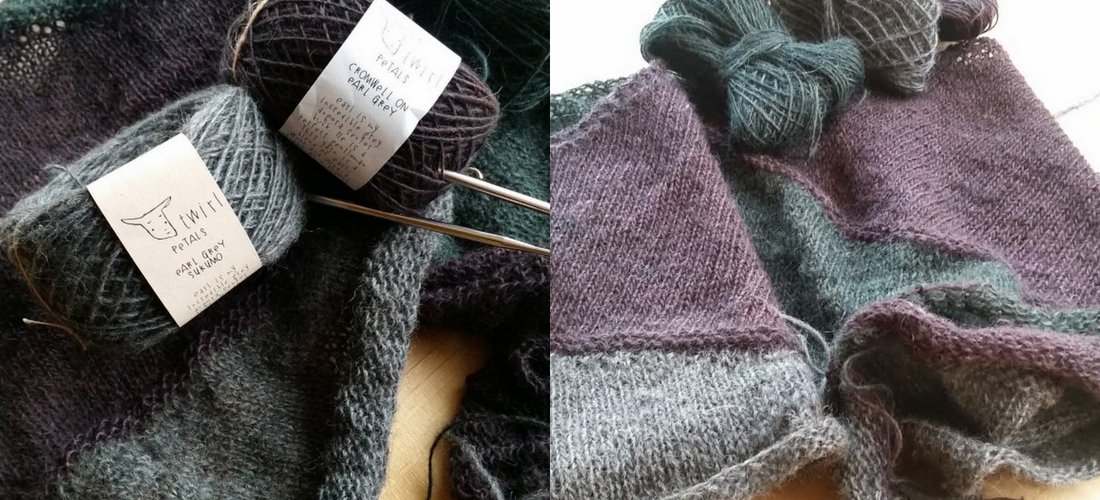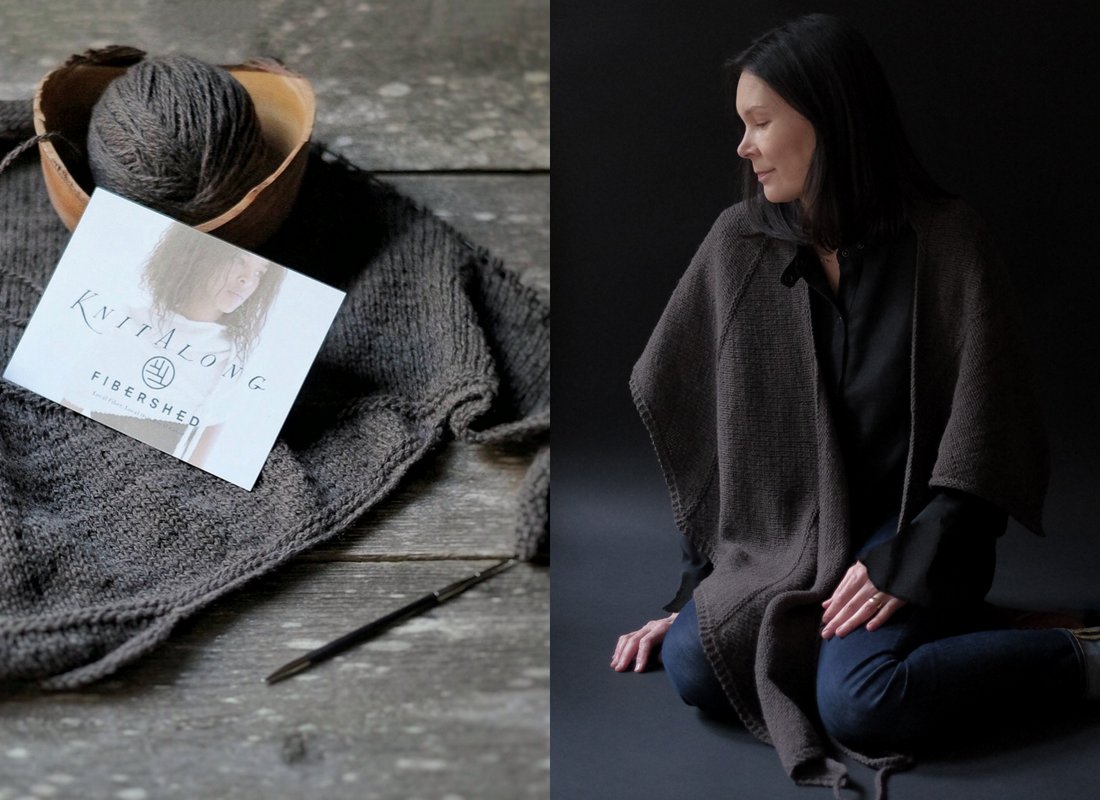
This is the second blog featuring the Fibershed Knitalong, a collaborative endeavor to support us all growing closer to the land that shelters us. If you missed the first blog, read about the project and the ‘Roundtable’ of knitters who joined in to kick off this community effort. Here, we checked in with Fibershed members and supporters to reflect on this experience, asking each to share how the project went and if they have ideas for their next local fiber project already. Did you join the Knitalong? Let us know about your experience in the comment section.
Above, a simple map displays the geographies of the 36 participants who registered their Knitalong project through our sign-up sheet. Be sure to explore #FibershedKAL on social media to see and read more about individual projects, the local fiber and dyes that were incorporated, and the narratives that emerged around ‘the love of place.’
If you haven’t had a chance to join in yet, we welcome you to pick up and knit whenever you are inspired — the Radiata pattern, designed by Emily Cunetto, is beautifully adaptable to nearly any yarn, and we encourage you to continue to explore prosumption, the act of bridging the space between producer and consumer, by connecting with those who raise, process, and provide fiber. We would love to see your process and creations using the hashtag #FibershedKAL.
Now for the Roundtable…
Northern California Knitters
Shelli in Petaluma, Knitterly

I really enjoyed the rhythm of the pattern. I was able to use three shades of the alpaca two sections per shade so six sections total and it is the perfect size. I will wear it as a Shawl/ Cowl all cozy in my jacket and over my winter tops to keep me warm inside the house. I am casting on for my second in Radius Bulky…. super quick and super textured!
I’m all about the locally sourced anything! I’ve been eating locally sourced food for as long as I can remember, it’s very important and very basic, eat what is natural, from farmers near you, and you’ll be healthy, so it makes so much sense to use natural fibers from farmers near you, I can feel the wholesomeness and pride in the local fibers I use. I’m so proud to be in an industry that has enough like minded people that Fibershed can exist and flourish.
Since I have a yarn shop full of Local Fibers the possibilities for my next project are endless 😉
I’m working on a Stephen West pattern Called Samen, I’m using Twirl Petals in soft colors, it’s going to be sweet and romantic. I’ve made a couple sweaters out of the Twirl and they are some of my favorite things. I really enjoyed this pattern. I didn’t have to struggle to follow it and it was such a joy to use the different shades of grey. I will use this pattern again with some super colorful Twirl and can’t wait to see the results.
+ Visit Knitterly online and in-person
+ Follow @KnitterlyPetaluma for Knitalong and other updates
+ Learn more about Knitterly on the Fibershed blog
Diane Dias in San Francisco, Imagiknit

I really enjoyed working on this project! It’s a fun pattern and the yarn was such a joy to work with. I plan on wearing this shawl all of the time. This is my first hap-style shawl and I think I’m going to love wearing it. I loved the idea of a KAL using locally sourced fiber. Just knowing that the yarn in this shawl is made from animals that graze so happily a hop, skip and a jump away from San Francisco is such a great thought. I want to make another Radiata – this time using Twirl Ditto.
+ Visit ImagiKnit online and in-person
+ Follow @Imagiknitsf for Knitalong and other updates
+ Learn more about ImagiKnit on the Fibershed blog
Justine, Cast Away & Folk

The project is going very smoothly. I love the monotony of simple patterns, and the modular aspect of it is enough to keep me excited about the next section. I’m not finished with it yet, since as a shop owner I am always working on shop samples so I have been a bit distracted. But I am on my 4th panel! I made my piece at a smaller gauger than suggested since I am such a small person (not even 5 feet tall!) so I plan to wear mine more like a scarf than a shawl/wrap.
I loved the excuse to choose my favorite color of Mary’s Twirl yarn. She had just brought in a delivery so when receiving it I was even more than usual excited as I was choosing my own color as I checked it in. My staff member Megan who ran the shop shop knit along also chose one of Mary’s yarns- I did the Petals and she did the Ditto. Knowing where the fiber comes from and having that personal relationship definitely adds to the richness of the knitting experience. I actually really want to use the Twirl Cotton Coyote and might make another larger (on gauge) shawl with that next!
I would really like to team up with Fibershed for some type of event at my shop! I also recently met a person who is opening a local mill so I am intrigued to possibly work with them next year on a custom yarn for my shop. I really like modular patterns, I had a couple of ideas while knitting this one! Still brewing…
On Cast Away & Folk’s Knitalong events
Because of the time of year (holidays) we haven’t had a big turnout, but customers working remotely have been in touch and everyone loves the uniqueness of the shape, plus the simplicity of the pattern! It’s the perfect skill level for a shop knit along.
+ Visit Cast Away & Folk online and in-person
+ Follow @Castawayandfolk for Knitalong and other updates
Farther Afield Roundtable
Kathy Cadigan in Carnation, Washington, with Snoqualmie Valley Yarn

Participating in Fibershed’s Knitalong has been a wonderful experience. I kept thinking as I was knitting Emily Cunetto’s beautifully designed Radiata shawl how perfectly the five knitted segments represent all the people and places connected to the yarn I used for the project:
Jeff and Katya who raised the sheep in the Snoqualmie Valley near where I live; the wonderful people at environmentally conscious Green Mountain Spinnery in Vermont: David, Kate, Maureen, Lauren, Tracy, Larisa and Laurie who milled the wool in to yarn; Emily of Local Color Fiber Studio who grew the Sumac she used to dye the yarn; myself, the knitter; and of course Anna of Tolt Yarn and Wool whose wonderful shop and idea for a local yarn connected us all.
I’ve been fortunate enough to meet and know in-person all the people involved in producing Snoqualmie Valley Yarn and I’ve had the privilege of traveling to and standing on a patch of earth connected to each of them– wearing my shawl is literally a touchstone for those encounters.
I’m grateful to Fibershed for giving all of us, no matter where we live or what we do for a living, the resources to gain a deeper understanding of our distinct bio regions by connecting to producers of regionally grown fiber.

+ Follow @Kathycad for Knitalong and other updates
Ani Lee in Tasmania / California, with White Gum Wool from Australia

I have found it particularly challenging to stick with the Fibershed KAL, and not because of the pattern or anything like that, actually just the timing of it all. I have been barely treading water with holiday present knitting, and my knitting attention (which is pretty scattered at the best of times), is even more diverted.
Then the KAL itself has come into my life at such an interesting time – it started, and I decided on my materials when I was in Hobart, Tasmania, a place I have fondly (and quickly) called ‘home’, though the bulk of the time the KAL is running, I am residing at my true ‘home’, or at least my first home, my home for the first 17 (21?) years of my life – my childhood home.
Now, having a life split between two continents – and I say life because this has been my reality for my adult life – is confusing, and sometimes really challenging. I completely acknowledge the immense privilege I have with being able to smoothly move back and forth between these two countries as I wish to – I know this is not a privilege many people in the world have (though they should, but I digress), but it doesn’t lessen the intensity of having a life like this – people over here, some over there – many thousands of miles apart.
I constantly question what it means to be “home”, to love a place so deeply, but also to recognize that perhaps a love of place alone is not enough. I love Hobart. I love Tasmania, I love it with all my heart. But how do you reconcile a love of a place formed so deeply and quickly (that you feel in your very core, not to get too woo woo for you) with a familiarity of place across the world – one in which you have family, community? A place where you’re pretty sure if you aren’t yet in love, you could learn to love.
I know these thoughts are probably very different to what the intention of the KAL was – but they seemed worth sharing. Maybe someone else out there has been living life, loving many places, never really getting to establish roots, and maybe they’ll find this and feel less alone. Or maybe I just needed to get it off my chest.
As for my actual plans with the KAL, I’ll tell you this – I think it’s such a beautiful concept, I’m loving seeing others’ interpretations of Love of Place. I’m a few rows into my shawl at this stage and I am thinking, if I can finish her before I head back to Hobart, I’d like to try dyeing her with California Buckeye – although a Google search didn’t yield much in the way of any suggestions for dyeing with buckeye.
Or I might not dye it at all, and that would be okay, too. I’m just happy to have gotten a chance to participate in the KAL and have some genuinely tricky, but also important, thoughts come up.
Community Contributions
Each week we highlighted a community entry to the #FibershedKAL pool. The images and narratives shared are wonderful to read, and it was hard to pick just one each time! Here is a snippet from each:

Left: Dawn (@dmwf9011) knit a cozy shawl in bulky alpaca yarn from her fibershed in the Chicago area, writing: “Local reminds me to be mindful in my actions – what I buy, what I consume, and what I value. Local represents someone’s dreams and visions. Local acknowledges the art and courage of my community. This humble shawl is a beautiful conversation with the earth.”
Center: Helen (@Helen_Krayenhoff) played with purple basil as a natural dye from her backyard, using modifiers to extend the color palette on Lani’s Lana yarn purchased from the farmer’s market.
Right: Lisa (@h2oNina) naturally dyed yarn with a different local source for each segment, including madder root, coreopsis & buddleia flowers, bolete mushrooms, using fiber called “lamb camp yarn” from a farm she visits each year in Kentucky.
Thank you to the Fibershed Producer members who generously donated prizes: Jackie Post, with Sheep to Shop felt hot pads (link to Marketplace), Mary Pettis-Sarley with 2 skeins of Twirl Yarn, Colleen Simons with a skein of local yarn from Fiber Confections, and Red Twig Farm with dye garden seed packets of indigo and coreopsis.
Thank you to everyone who joined in and knit along within your fibershed!
